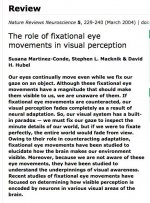I've come a bit late to this thread and missed that some interesting science was being discussed. I'm sure I haven't followed everything but Alexis in particular seems to have done a good job of keeping things on track. It's not an area of science that I know a great deal about, and I know I've only skated over the surface a very complex topic but I have managed to extract a few details that are pertinent to the discussion.
I suppose all of us imagine the view that we 'see' is a faithful reproduction of the image projected on our retinas. It's not. The raw information has been subjected to a whole range of physiological and psychological manipulations which in places parallels significant Photoshopping on the macro and micro scale scale and at times, a fair bit of CGI as well.
When light strikes the photo receptors of the eye a chemical conversion of a protein occurs and when 'enough' is produces a signal is sent along the optic nerve. What constitutes 'enough' is not fixed, it is modulated by the other receptor activity going on around it so the sensitivity can be cranked up or damped down. On top of that the photochemical degrades so if 'enough' isn't produced in a given time then no signal is produced. Now we have a dynamic situation where for each receptor there is a finite amount of time for a signal to be produced or not. If if a signal is produced there is a insensitive period where it can't fire again. It sort of compares to an exposure time, but rather than the image being processed frame by frame it's an asynchronous process, which means there is a finite time required for all the information in the view to be accumulated and sent for further processing. If the flash of information is too short no image or only a partial image reaches the brain. For film or TV the frequency of the images means that there is insufficient time for individual frames to be sent to the brain and processed before the next is shown. We get a situation where the information from one frame is still getting sent when the information from the next is simultaneously on it's way. The result is that at 24 frames per second or faster the view scene appears continuous.
Even that description is only scratching the surface of the mechanisms involved. Besides the control at the retinal level there are several intermediate stages on the way to the brain where pre-processing occurs, but the fastest time an event can reach the brain is in the order of 1/10th of a second, and generally what we might call an image will take around 1/5th of a second to form.
That's probably more than enough for now but if you do a search on something like "cone temporal sensitivity modulation" you should find more on the story. It's not easy stuff to read but believe it or not this paper is more legible than most:
http://macboy.uchicago.edu/~eye1/PDF files/Swanson Ueno JOSA 87.pdf
David





